Mums might give your dog the runs so be sure to keep your chrysanthemums out of reach of curious paws and slobbery mouths.
Chrysanthemums, often affectionately called “mums,” are popular ornamental fall flowers known for their vibrant colors and beautiful flowers
They are common garden plants seen in backyard gardens, floral arrangements, and are often used as front porch decorations in the fall.
While this beautiful flowering plant may be a seasonal fall favorite for humans, it’s important to remember the potential dangers they might pose to our dogs.
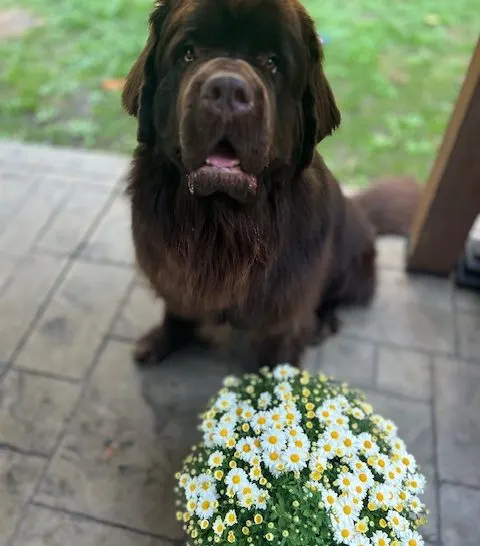
In this post, we’ll dive into the delightfully ironic realm where chrysanthemums, those colorful, innocent-looking blooms, hold the secret to canine chaos.
Welcome to our satirical exploration of the canine conundrum: Are mums toxic to dogs?
Spoiler alert: They are!
Are Mums Toxic to Dogs?
Yes, mums, also known as chrysanthemums can be toxic to dogs.
These colorful blooms do indeed have a dark side and they are listed on the ASPCA’s list of fall poisonous plants that are mildly toxic to dogs.

The Dastardly Dilemma
How can it be that one of fall’s most popular flowers is toxic to our dogs?
It’s quite simple.
Mums contain pyrethrins and pyrethroids, which sound like ingredients for a magical potion but are actually natural insecticides.
These compounds can wreak havoc in a dog’s world, making mums not just garden decor but also potential canine kryptonite.
Dangers of Chrysanthemums for Dogs
The entire plant is poisonous and contains sesquiterpene lactones, pyrethrins, and several other toxic substances.
Both the lactones and pyrethrins are used to produce insecticides and can affect sodium channels in your dog’s body
This reaction, when a dog eats large amounts of the plant, can lead to low blood pressure, respiratory failure, irregular heartbeat, loss of coordination, coma, and while rare, can lead to death in extreme cases.
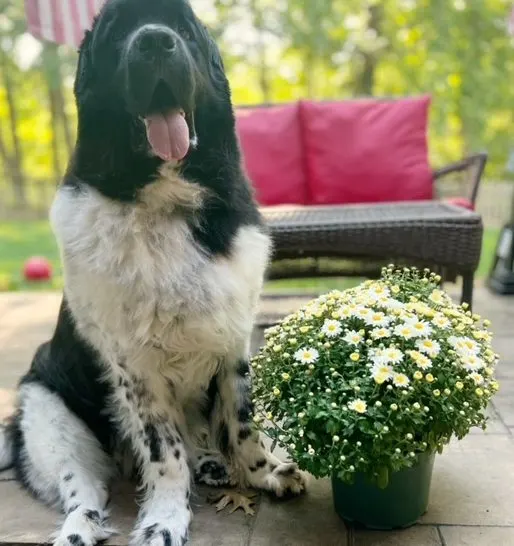
Potential Pooch Perils (the worst of the worst)
If your dog takes a nosedive into your perfectly potted chrysanthemum here are a few worst case tales that could play out in their dramatic attempt to ruin all of your festive fall plans.
- Ingestion Intrigue: In a plot twist worthy of a daytime soap opera, your dog might decide to become a botanical gourmet and sample some chrysanthemum cuisine. In this culinary escapade, they might nibble on leaves, stems, or flowers, setting the stage for a garden-variety drama.
- Gastrointestinal Gala: Chrysanthemum consumption can lead to a canine soiree of gastrointestinal upset. Vomiting, diarrhea, and drooling are the stars of this show, making your dog the unwilling protagonist of an unappetizing tale.
- Neurological Nonsense: For those dogs who crave a more thrilling storyline, severe chrysanthemum poisoning can provide it. Imagine your pup starring in their action movie, complete with tremors, excessive salivation, and even seizures.
- Skin Saga: But wait, there’s more! Chrysanthemum contact can also lead to a skin irritation subplot. Your dog may sport an itchy, red, and inflamed look that even the best canine makeup artist couldn’t cover up. Your dog’s mouth might even be involved. No, it’s involved.
- Allergic Antics: Some dogs can have allergic reactions, featuring itching, hives, and swelling, turning your dog into the star of their very own medical drama.
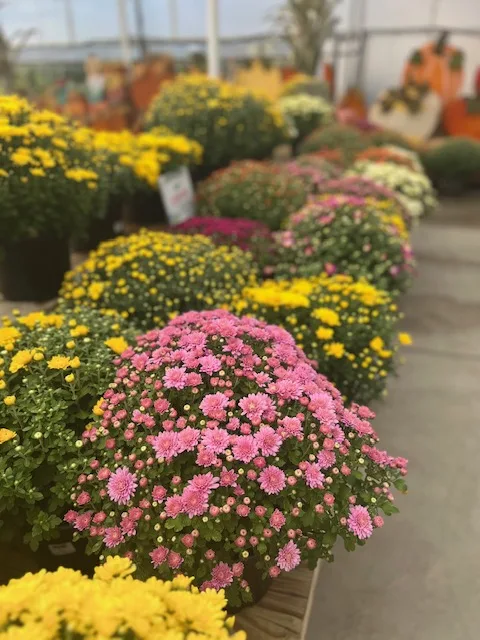
When will these terrible tales show up?
Symptoms of mum (chrysanthemum) poisoning in dogs don’t wait for the perfect time to make an appearance.
Most dogs will begin to show signs of poisoning within 24 hours of consumption.
To make it crystal clear, common symptoms of mum poisoning in dogs are:
- Upset stomach
- Drooling (excessive drooling for dogs like Newfies that drool on the regular)
- Skin irritation
- Excessive scratching
- Vomiting
- Diarrhea
- Loss of appetite
- Coughing/gagging
- Oral irritation
- Pawing at mouth
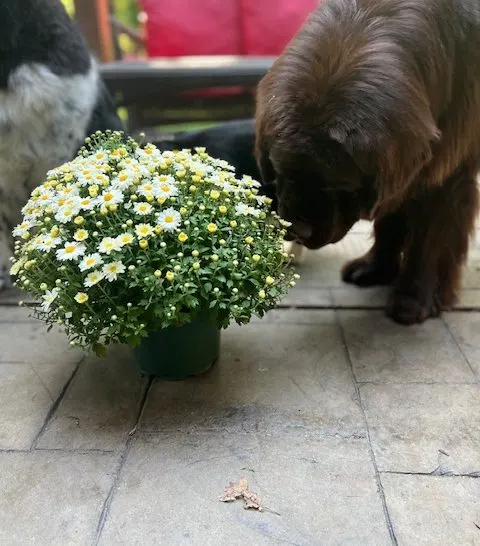
Serious symptoms include:
- Abdominal pain
- Lack of coordination/stumbling
- Dilated eyes
- Cardiac arrhythmias
- Fever
- Breathing difficulties
- Bloody diarrhea
- Severe vomiting
- Shaking
- Seizures
While I’m writing this in a playful tone, the reality of mum poisoning in dogs is nothing to mess with but as a retired vet tech, let me tell you that in 10+ years, I never saw a dog with serious mum poisoning at my clinic.
Upset stomach, yes.
A little itchy, also yes.
But that’s not to say that it can’t happen so it’s better to know what to look for than to be caught off guard if your dog decides to take a nose dive into your favorite fall plants this year.
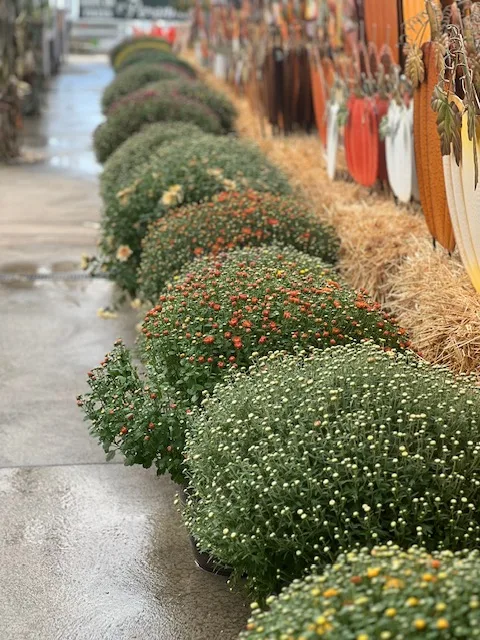
What to Do If Your Dog is Exposed to Chrysanthemums
If your dog takes a sniff of your new mum or even a small nibble from parts of the plant, they’ll most likely be just fine but if you suspect that your dog has plucked a mouthful of blooms out and ingested them, it’s important to check in with your veterinarian and also to check their mouth.
In case your dog decides to embrace the world of floral folly here’s your next steps:
- Veterinary Vaudeville: Summon your veterinarian or the nearest animal clinic. Call your veterinarian and let them know that your curious and dirty-mouthed pup sucked up those mums when you weren’t looking. Make sure to provide them with any symptoms your dog might be experiencing no matter how little.
- No Vomiting Voodoo: Avoid trying to induce vomiting unless your veterinarian casts a spell for it. Sometimes, trying to play a hero can lead to more trouble than triumph.
- Intense Inspection: Keep an eagle eye on your dog’s condition while waiting for professional guidance. If your dog exhibits severe symptoms, such as seizures, irregular heart rate or difficulty breathing, seek emergency care immediately.

Prevention Is Key
Prevention is always key when it comes to keeping our dogs safe but prevention doesn’t understand how some curious and devil worshiping dogs work.
However, obviously, preventing exposure to chrysanthemums is the best bet to protect your dog from potential toxicity and digestive upset.
Here are some preventive measures that may or not work depending on how creative your dog is:
- Chrysanthemum Concealment: If you have chrysanthemums and a dog, consider a botanic breakup or at least keep them under wraps. Remove them or place them in an area where your dog can’t get their dirty, stinky paws on them. Like behind locked doors where no one can enjoy them or just stick to rubber plants.
- Educate for Entertainment: Learn to identify the entire chrysanthemum family for a more thrilling walk with your dog. Who knew botany could be an adventure?
- Supervise Your Dog: Keep a vigilant eye on your devilish dog during garden strolls to ensure they don’t succumb to the allure of new plants and forbidden flowers. When encountering outdoor plants, don’t turn your back on your dog for a second, that’s what he’s waiting for you to do.
- Train Your Dog: Enroll your dog in obedience training, because what’s more entertaining than a dog who knows not to snack on the set? Stop being a slacker. Basic obedience training can be incredibly helpful in preventing your dog from ingesting toxic plants or substances.
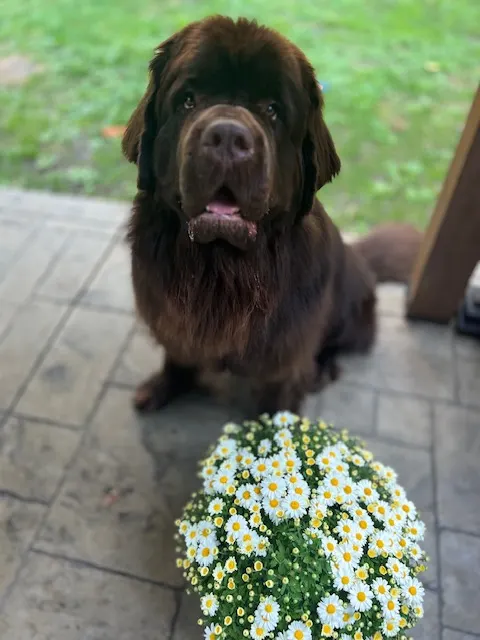
What Variety Of Mum Are Toxic To Dogs?
With several varities of mums out there in different shapes, sizes and blooms it’s not easy to head to the local flower shop and figure out which one is the most toxic to dogs.
However, the most common reactions in dogs have been found to come from these Asteraceae family members:
- Chrysanthemum (most common name)
- Chrysanths
- Corn daisy
- Daisy
- Garland chrysanthemum
- Hardy garden mum
- Indian chrysanthemum
- Tricolor daisy
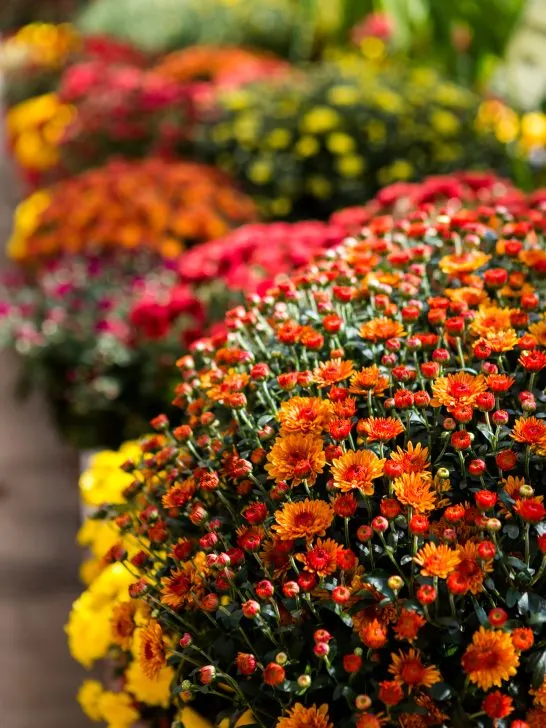
A Dramatic Prognosis
If you’re sitting on the edge of your chair right now waiting for the good news, it’s right here.
Recovery of chrysanthemum (mum) poisoning in dogs is quite, dare I say, good.
When treated promptly and properly, these chrysanthemum toxins, much like fleeting celebrity romances, don’t stick around for long.
Their effects should exit the stage within a mere 24 hours, leaving your dog ready for more creative performances.

If your dog had to make a trip to the vet to admit their devilish mistakes, upon their triumphant return home to their castle, it’s essential to create a serene sanctuary for their recovery, a sort of canine spa retreat, if you will.
Expect your veterinarian to recommend a diet that’s probably fancier than anything you’ve ever eaten yourself.
It’s your dog’s moment to shine as they savor gourmet delights for the next several days.
Now, don’t forget the essentials: ensure your pet has an ample supply of water, because staying hydrated is crucial when you’re recovering from a floral folly.
And remember, in this grand spectacle of life, you’re now the watchful audience, eagerly awaiting the next act.
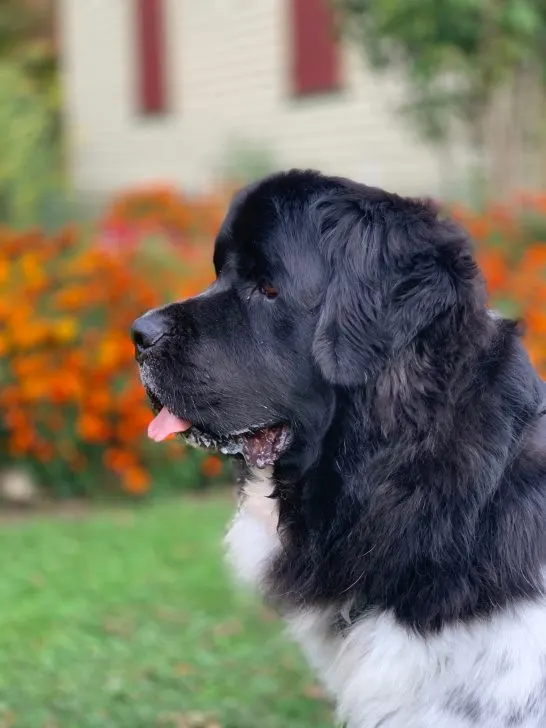
Watch for them, as they might decide to join the performance fashionably late.
While recovery from chrysanthemum poisoning is typically smooth, unforeseen hiccups can occasionally steal the limelight.
Will your dog decide to add a dramatic twist to the story?
In this grand comedy of errors, the key is vigilance.
Keep a close eye on your pup and report any unexpected developments to your veterinarian.

Conclusion: A Flowery Farce
In the world of canine capers, chrysanthemums may seem like the perfect subplot for your pet’s escapades.
Still, as responsible pet owners, it’s our duty to ensure they avoid the perils of these bright flowers with pretty petals.
Remember, the next time your dog contemplates a floral feast, you have a satirical script in your hands—complete with drama, danger, and perhaps a dash of dark comedy.

Other Darkside Fall Dangers For Dogs
As if that’s not enough drama to dampen our fairytale fall festivities, besides chrysanthemums being harmful to dogs, there are also several other fall hazards lurking right in front of us including:
- wild mushrooms
- ticks (ticks love to hide in dark places such as leaf piles)
- oak leaves
- corn cobs
- xylitol